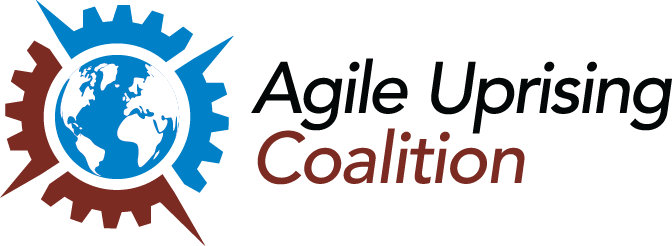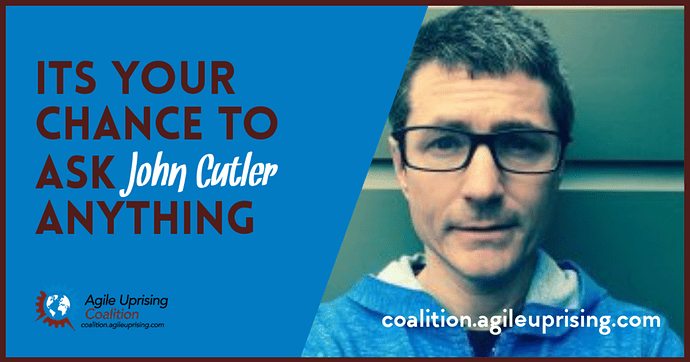Please use this topic thread to post your questions directly to John Cutler. John will be answering YOUR questions September 17-24th 2018.
ASK John Cutler
John: Please describe your creative process – in particular, how are you so prolific?? In the time I’ve written this question, you’ve probably posted 14 Tweets! You produce more material than most Scrum Teams I know! Are you seven people? Do you never sleep? What is your secret?
John,
Several of your posts describe burning out or burning through a job because of being a change agent.
It can take a toll on a change agent to be misunderstood, have motives questioned, and to be labelled a troublemaker when you are just trying to help.
How do you tackle self-care amidst those challenges? What advice do you give to others who find themselves in similar situations?
Hey John - I noticed your drawing a while back in LinkedIn on Kanban. It was a curious one and I wanted to know more about your thinking behind the drawing. Could you add a few words to what you drew?
Thanks! -Joey
Hello David
The secret is…a low level of self-filtering. My writing, doodling, and tweeting is largely a byproduct of my daily brainstorming, ruminating, and general pondering about product development. I try not to overthink it. With my Medium posts, I set a time-limit (e.g. 60 minutes) and commit to publish whatever I have done by the end of the timebox. The doodles come out of my daily doodling (hurray iPad Pro!).
Sometimes the quality suffers, and I am OK with that. I actual have a day job now that involves writing some content, and I can tell you that the higher bar is a limiter. My perfectionism starts to show through! I worry more. But for my hobby writing I have always been happy with just setting a timer, and pressing publish at the end. Maybe that is it…the speed of my writing is a response to knowing that crippling perfectionism lurks around the corner, so I have to real shut that side of the brain off.
I real eye-opener was an app called FlowState. With FlowState, your writing disappears if you stop writing. You HAVE to finish. I started to practice…working up from 1m, to 3m, to 5m to 60m. It is thereuptic almost. You (cliche) “get in the flow”, and don’t self-censor as much.
I would encourage anyone/everyone to write more. It is a muscle for sure (I always doubted people when they said that before). Don’t worry too much about grammar and punctuation if doing so isn’t your day job. And finally…you almost have something interesting to share.
Hi Joey
The goal with kanban is obviously “flow”. That said, “waterfall” can also look like “flow” from a certain angle. I drew this while thinking about the appropriate number of columns in a kanban board. I am definitely a proponent of “start where you are now” — modeling the system as it is, and not how you would like it to be. However, I see many product teams institutionalize hand-offs in the design of their boards without questioning that design decision. What many people call agile is really a tiny phase of agile built into a larger waterfall (agile-fall). This was a hint at that as well. In my mind, fewer columns are better because they indicate working together vs. handoffs.
Many people take handoffs for granted. For example, I talk to many agilists who assume that designers must “design” something prior to it hitting the team-working-in-an-agile-fashion. I see why that might make sense, but I have seen “starting together” as a very powerful pattern — with designers and developers pairing on the design vs. design upfront.
Hope that shows some of the thought process … basically, a kanban board can model waterfall as well :). It is very much agnostic to how you work.
Hi Don
I wish I had the silver bullet for self-care, but I don’t. The one bit of advice I have been giving lately is to make an agreement with yourself about how long you’ll toil away at changing an org from the inside. It is hard, and we tend to rationalize “just one more month”. I see interventions as mini-experiments. If the signals from those experiments continue to be negative, then that’s a sign. Provided you’ve given it an honest try, sought outside help where needed, and kept your relationships intact…well, you’ve likely done your best. It is better at that point to seek a new environment.
So maybe, in short, conduct safe to fail experiments, observe the outcomes, and act accordingly before getting sucked in.
Good luck!
Wow. There are so many awesome events out there. I only went once, but I was a big fan of the Open Agile NorCal event held a couple years ago. I love that format. Why? You had some super smart people being very vulnerable in the non-traditional format. People were open and accessible. It really was wonderful.
Thanks, John. I appreciate your response. Your description gives me a better understanding of the picture you drew. Having done a good bit of work with Kanban, I almost thought it was a criticism of Kanban as a waterfall method, which I didn’t see as making a lot of sense. Now I understand. I agree with your concern about design of boards without questioning the design. I’ve seen a few too many examples of where large firms get one person trained in Kanban system design and then assume that their initial design can be replicated across many different services. Using the same Kanban system configuration for another service is unlikely to succeed and usually ignores healthy mutations or experiments between like services. This kind of goes back to a criticism Steve Denning has about exec’s who have said agile related work is an operational patch and not an shift in mindset.
Hi John! From your experience, what is it that makes most organizations still struggle with a truly agile mindset? Almost everyone is hiring Agile Coaches nowadays, but in the end very few companies succeed in becoming agile. Quite often you find teams and team leaders who are really dispeared as the are left alone on their agile journey. Is there a message you would have for them? Many thanks for answering!
Pure inertia. This is really, really hard. It is tempting to make it about mindset and general openness to change, but to shift the path of an elephant is very difficult. The message I would give people is to really invest time in carving out a system with boundaries that you (and your teams) can broadly “control”, and work from there. Pay attention to the I/O of that little neck of your woods, and make improvements that stick (even if they are localized). First, I think this will improve your quality of work life, and second I think this is a good way to stay sane and play the long game.
Also, and this may seem cynical but it isn’t (I promise), sometimes leaving is your best option. Run experiments to see if more is possible in your current work environment, and then weigh your options. I see a lot of coaches get very attached to “fixing” a certain situation, and in the process hurt their own careers and wellbeing. Give it your best shot, of course, but remember to take care of yourself!

